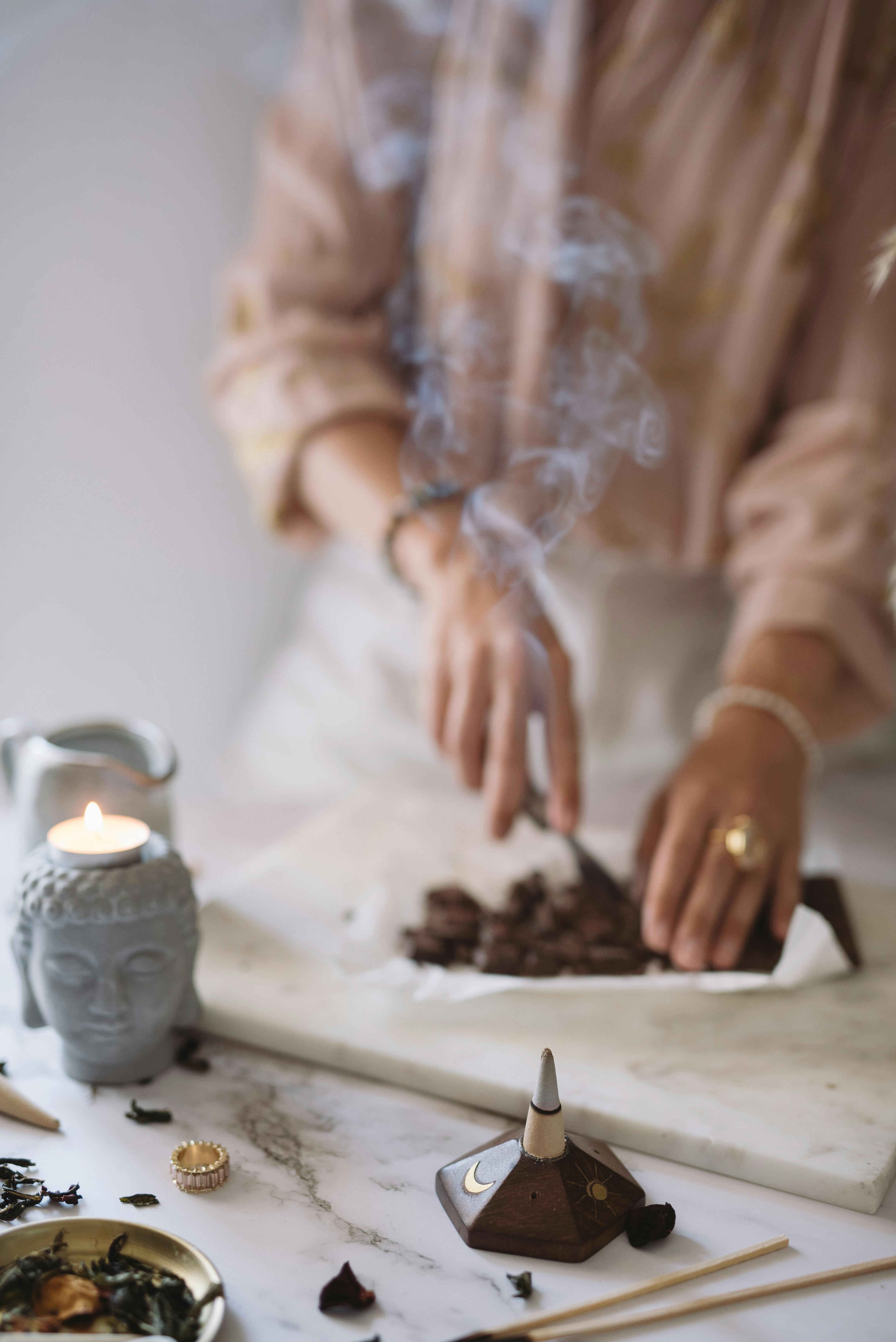Exploring the sensory experience of a cacao ceremony is about more than tasting a warm cup of cacao—it is about noticing every detail, from the aroma of the ground beans to the gentle sound of stirring the liquid.
This ancient tradition, rooted in Indigenous cultures, connects participants to both the physical senses and deeper states of awareness.

In modern wellness settings, people often compare ceremonial cacao vs cacao from a nutritional and energetic perspective, appreciating the difference that intention and preparation can make in the sensory experience.
The History Behind the Cacao Ceremony
Exploring the sensory experience of a cacao ceremony begins with understanding its origins. Cacao ceremonies have a long history in Mesoamerican cultures, where they were an integral part of community gatherings.
Ancient Ritual Use
- Held during seasonal celebrations and life transitions.
- Offered as a drink to honour deities and strengthen social bonds.
- Prepared with spices such as chilli and cinnamon to add depth to the flavour.
Transition to Modern Practice
While the setting has evolved, many of the sensory aspects remain unchanged—participants still gather, prepare cacao with care, and drink it with mindfulness.
The Setting: Preparing the Space
Exploring the sensory experience of a cacao ceremony involves creating an environment that invites focus and presence.
Visual Details
- Dimmed lighting or soft candles to enhance calm.
- Arrangements of flowers or natural elements to connect with the earth.
- A circle of cushions or chairs for comfort and equality.
Sound Environment
- Gentle music or the quiet hum of conversation.
- The sound of grinding cacao beans or stirring the drink in a pot.
The First Sense: Sight
Exploring the sensory experience of a cacao ceremony often begins with sight. The visual elements set the tone before the first sip.
Observing the Ingredients
- Deep brown cacao paste, sometimes flecked with lighter tones.
- Steam rising from the cup.
- The way light reflects on the surface of the liquid.
Watching the Preparation
Noticing how the cacao melts and blends with water can be a mindful exercise, connecting the participant to the process.
The Second Sense: Smell
Exploring the sensory experience of a cacao ceremony moves naturally to smell, which is one of the most powerful triggers for memory and emotion.
Aroma of the Cacao
- Earthy, rich, and slightly bitter.
- Spices such as cinnamon or cardamom adding warmth.
- The faint sweetness of natural sweeteners like honey.
Impact on Mood
The aroma alone can create a feeling of comfort and anticipation, preparing the mind for the ceremony ahead.
The Third Sense: Touch
Exploring the sensory experience of a cacao ceremony includes the physical sensation of touch, both through the hands and the mouth.
Holding the Cup
- Feeling the warmth of the vessel in your hands.
- Noticing the texture of the cup—smooth, rough, or handmade.
Physical Sensation of Drinking
- The liquid’s thickness on the tongue.
- The way warmth spreads through the body after swallowing.
The Fourth Sense: Taste
Exploring the sensory experience of a cacao ceremony often centres on taste, but here it is approached slowly and mindfully.
Flavour Layers
- Initial bitterness of pure cacao.
- Subtle sweetness from added natural ingredients.
- Spicy or floral undertones depending on the recipe.
Mindful Sipping
Taking small sips allows each flavour to unfold gradually, deepening the appreciation of the drink.
The Fifth Sense: Sound
Exploring the sensory experience of a cacao ceremony may also include sound, which is sometimes overlooked in drink rituals.
Sounds During Preparation
- The scraping of cacao paste being chopped.
- Water simmering before mixing.
- The whisking or stirring that blends the ingredients.
Sounds in the Ceremony Space
Soft music, drumming, or even shared silence can enhance the meditative quality of the ceremony.
Emotional Awareness in the Ceremony
Exploring the sensory experience of a cacao ceremony is not only about physical senses—it also includes emotional states.
Cacao’s Role in Emotional Openness
- Gentle stimulation supports focus without agitation.
- Nutrients like magnesium help release tension.
- The ritual setting encourages trust and vulnerability.
Group Connection
Sharing personal intentions or reflections can deepen the emotional impact of the experience.
Physical Responses to Cacao
Exploring the sensory experience of a cacao ceremony also means noticing the body’s response.
Common Sensations
- A gentle increase in heart rate from theobromine.
- Warmth spreading through the body.
- Relaxation in the muscles from magnesium.
Balancing Stimulation and Calm
Many participants find themselves alert yet grounded, making it easier to stay present.
Combining Cacao with Other Practices
Exploring the sensory experience of a cacao ceremony can be enhanced by integrating other mindful activities.
Movement Practices
- Gentle yoga or stretching before drinking.
- Free-form dance after the ceremony begins.
Meditation
- Guided breathwork to heighten sensory awareness.
- Silent sitting to focus on inner sensations.
Respecting the Cultural Roots
Exploring the sensory experience of a cacao ceremony should also honour the traditions from which it comes.
Ways to Show Respect
- Acknowledge the cultural heritage when hosting.
- Source cacao ethically from Indigenous growers.
- Learn about traditional preparation methods.
Ethical Choices
Choosing organic, fair trade cacao supports both the environment and the farming communities.
Tips for Hosting a Sensory-Focused Cacao Ceremony
Exploring the sensory experience of a cacao ceremony as a host requires careful preparation.
Preparation Checklist
- Choose a calm location with minimal distractions.
- Gather quality cacao and supporting ingredients.
- Prepare music or sounds that support focus.
- Arrange seating to encourage openness.
- Guide participants through each sensory step.
Guiding the Group
Encourage participants to notice each sense in turn—sight, smell, touch, taste, and sound—before moving into emotional reflection.
Conclusion
Exploring the sensory experience of a cacao ceremony reveals how a simple drink can become a full-body, mindful practice.
By engaging all five senses—sight, smell, touch, taste, and sound—you create a deeper connection to the moment and to the tradition behind the ceremony.
Whether shared with others or enjoyed in solitude, cacao can be both a physical pleasure and a meaningful ritual that supports awareness, connection, and presence.
Frequently Asked Questions
How long does a cacao ceremony usually last?
Most ceremonies last between one and three hours, depending on the activities included.
Can I host a cacao ceremony at home?
Yes, with careful preparation and respect for cultural traditions, you can host a small, sensory-focused gathering.
Is there a difference between ceremonial cacao and regular cacao?
Yes, ceremonial cacao is less processed and prepared with intention, while regular cacao is often processed at higher temperatures and used for general cooking.
